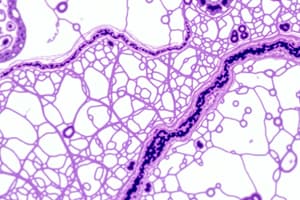Podcast
Questions and Answers
What is the primary purpose of histopathology?
What is the primary purpose of histopathology?
- To provide therapeutic treatments for infections
- To freeze tissue samples for preservation
- To study the physiological effects of diseases
- To examine diseased tissues at the microscopic level (correct)
How does the intraoperative (frozen section) technique assist surgeons?
How does the intraoperative (frozen section) technique assist surgeons?
- It provides immediate information on the patient's vitals
- It helps in assessing blood loss during surgeries
- It allows for quick analysis of tissue samples to guide clinical decisions (correct)
- It replaces the need for preoperative imaging
What is the main advantage of using a cryostat in the frozen section technique?
What is the main advantage of using a cryostat in the frozen section technique?
- It preserves the structural integrity of tissues indefinitely
- It enhances the resolution of microscopic images
- It enables rapid freezing of tissue for immediate analysis (correct)
- It allows tissue samples to be stained more vividly
What types of conditions can pathomorphological diagnostics help identify?
What types of conditions can pathomorphological diagnostics help identify?
Why might a surgeon use the frozen section technique during a surgical procedure?
Why might a surgeon use the frozen section technique during a surgical procedure?
What key feature do pathologists look for when diagnosing conditions?
What key feature do pathologists look for when diagnosing conditions?
What is the typical time frame for the analysis of a frozen section during surgery?
What is the typical time frame for the analysis of a frozen section during surgery?
Which of the following describes a primary component of pathological techniques?
Which of the following describes a primary component of pathological techniques?
What is the primary purpose of freezing the tissue during the intraoperative frozen section process?
What is the primary purpose of freezing the tissue during the intraoperative frozen section process?
Which staining dyes are commonly used during the intraoperative frozen section process?
Which staining dyes are commonly used during the intraoperative frozen section process?
What advantage does the intraoperative frozen section process provide during surgery?
What advantage does the intraoperative frozen section process provide during surgery?
What is a limitation of the intraoperative frozen section process?
What is a limitation of the intraoperative frozen section process?
How does the microscopic examination fit into the intraoperative frozen section process?
How does the microscopic examination fit into the intraoperative frozen section process?
In what situation might a surgeon decide to remove more tissue based on the results of the frozen section?
In what situation might a surgeon decide to remove more tissue based on the results of the frozen section?
Why might the intraoperative frozen section process not yield perfect results?
Why might the intraoperative frozen section process not yield perfect results?
Which of the following best describes the intraoperative frozen section process?
Which of the following best describes the intraoperative frozen section process?
What is the primary purpose of comparing infected tissues with healthy tissues during surgery?
What is the primary purpose of comparing infected tissues with healthy tissues during surgery?
What is a significant drawback of emergency histopathology compared to postoperative histopathology?
What is a significant drawback of emergency histopathology compared to postoperative histopathology?
During postoperative histopathology, what key aspect is assessed regarding removed tissues?
During postoperative histopathology, what key aspect is assessed regarding removed tissues?
What is the first step in the routine histopathology process after surgery?
What is the first step in the routine histopathology process after surgery?
What is used to prevent removed tissues from deteriorating during the fixation process?
What is used to prevent removed tissues from deteriorating during the fixation process?
Which factor is NOT typically assessed during the examination of a tumor in postoperative histopathology?
Which factor is NOT typically assessed during the examination of a tumor in postoperative histopathology?
What is the main goal of postoperative histopathology?
What is the main goal of postoperative histopathology?
How does emergency histopathology differ from routine histopathology in terms of efficiency?
How does emergency histopathology differ from routine histopathology in terms of efficiency?
What is the purpose of dehydration in tissue processing?
What is the purpose of dehydration in tissue processing?
Which chemical is typically used during the clearing phase of tissue processing?
Which chemical is typically used during the clearing phase of tissue processing?
What is the primary benefit of embedding tissue in paraffin wax?
What is the primary benefit of embedding tissue in paraffin wax?
How thick are the slices cut during the sectioning process?
How thick are the slices cut during the sectioning process?
What does Hematoxylin stain primarily color in the tissue?
What does Hematoxylin stain primarily color in the tissue?
What is the role of a pathologist during microscopic examination?
What is the role of a pathologist during microscopic examination?
Which of the following is NOT a focus of pathologists when examining tissue samples?
Which of the following is NOT a focus of pathologists when examining tissue samples?
What is the final outcome after a pathologist analyzes the tissue?
What is the final outcome after a pathologist analyzes the tissue?
What is the primary purpose of the postoperative procedure in histopathology?
What is the primary purpose of the postoperative procedure in histopathology?
During the histopathology process, what is the function of formalin?
During the histopathology process, what is the function of formalin?
What step follows the embedding of the tissue in paraffin wax?
What step follows the embedding of the tissue in paraffin wax?
Which dyes are typically used to stain tissues in histopathology?
Which dyes are typically used to stain tissues in histopathology?
What does a pathologist evaluate during the microscopic examination of tissue?
What does a pathologist evaluate during the microscopic examination of tissue?
After obtaining the findings, what is a crucial next step for the pathologist?
After obtaining the findings, what is a crucial next step for the pathologist?
Which of the following tasks is NOT part of the postoperative histopathology process?
Which of the following tasks is NOT part of the postoperative histopathology process?
What does the report generated by the pathologist typically include?
What does the report generated by the pathologist typically include?
Flashcards are hidden until you start studying
Study Notes
Introduction to Pathological Techniques
- Pathological techniques involve the preparation and examination of tissues to assess any disease-related changes.
- They can be classified based on when they are performed: intraoperative (frozen section) and postoperative (routine histopathology).
Intraoperative (Frozen Section)
- A fast technique used during surgery to provide immediate information about a tissue sample.
- Performed during surgery to guide immediate clinical decisions.
- Tissue is quickly frozen, sectioned, stained, and analyzed by a pathologist.
What is it?
- Used during surgery to determine tissue characteristics like cancerous nature or tumor removal completeness.
- Requires a small tissue sample analysis by the pathologist, often within 15-20 minutes.
How does it work?
- Tissue is rapidly frozen using a cryostat, allowing thin sections to be cut.
- Slices are then stained with dyes like Hematoxylin and Eosin to highlight cells and tissue structure for microscopic examination.
Why is it done?
- Provides immediate diagnosis, allowing surgeons to make informed decisions during surgery.
- Saves time by confirming diagnoses and treatment options, potentially avoiding further surgery.
Limitations
- Not as detailed as regular tissue processing due to potential tissue distortion caused by freezing.
- Not suitable for all tissues, especially those that do not freeze well.
Postoperative (Routine Histopathology)
- Tissue is processed and examined after surgery using standard methods.
- Provides detailed and accurate diagnosis of removed tissues, such as tumor analysis.
Purpose
- Thoroughly analyzes tissue to determine the disease present, its progression, and the success of surgical intervention.
Steps Involved
- Tissue collection: Removed tissue is sent to the pathology lab.
- Fixation: Tissue is placed in a fixative (usually formalin) to preserve its structure for examination.
- Tissue processing: Tissue undergoes dehydration, clearing, and embedding for preparation.
- Dehydration: Water is removed using alcohol.
- Clearing: Alcohol is replaced with xylene to prepare for the next step.
- Embedding: Tissue is placed in paraffin wax to harden and support for cutting.
- Sectioning: Tissue block is sliced into thin sections, placed on glass slides.
- Staining: Tissues are stained with special dyes (commonly Hematoxylin and Eosin) to visualize cellular details.
- Microscopic examination: A pathologist examines stained slides under a microscope, identifying abnormalities.
- Report generation: A comprehensive report is written including the diagnosis, severity, and tumor removal assessment.
- Communication with surgeon: The report is sent to the surgeon to guide further treatment decisions.
Studying That Suits You
Use AI to generate personalized quizzes and flashcards to suit your learning preferences.




